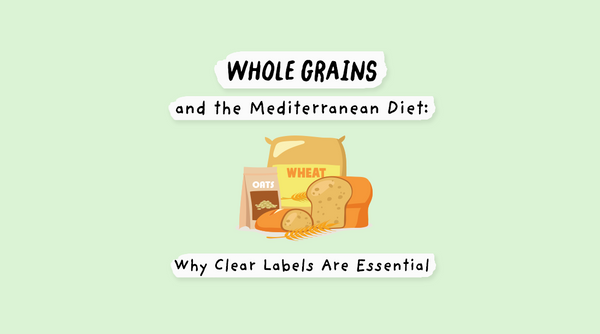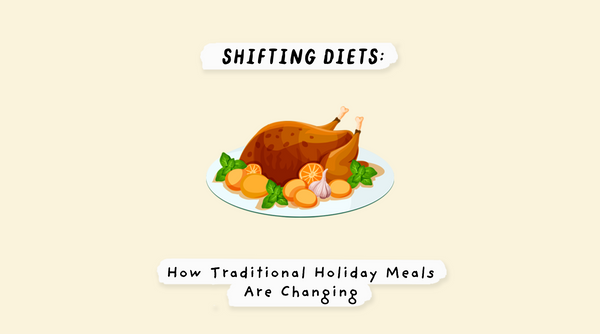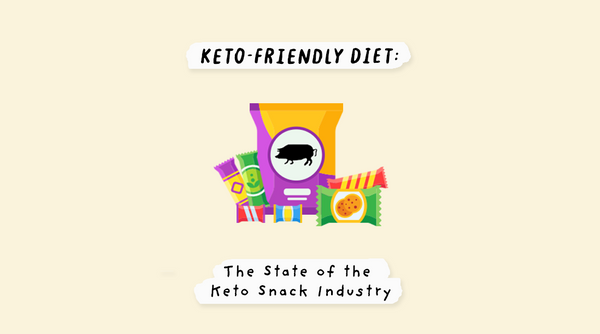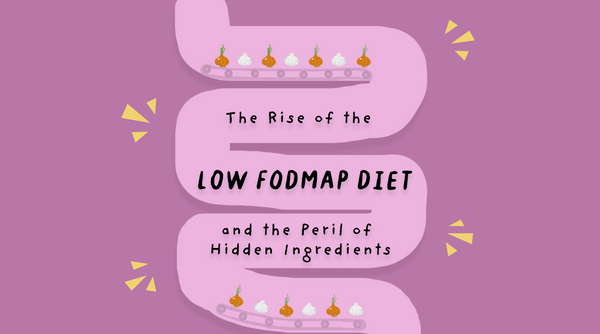A brief look
- Cardiovascular disease (CVD) is the leading cause of death in America.
- 121.5 million American adults have cardiovascular disease; that’s almost half of the U.S. adult population.
- The Mediterranean diet has been steadily gaining popularity as one of the top heart-healthy diets to manage CVD risk.
- Eating whole grains is one of the major tenets of the Mediterranean diet as it can lower blood pressure and cholesterol.
- Following this trend, manufacturers have increasingly included claims such as “contains whole grains” on their products.
- Consumers often think that the claim means that the product is made out of mostly whole grains, but there are often only minimal amounts – making it tricky to know if a bread truly meets the tenets of the diet.
Dive deeper
In the United States, 121.5 million adults have cardiovascular disease (CVD), which amounts to almost half of all U.S adults. More shocking, though, is that 1 in 4 deaths in the U.S. can be attributed to cardiovascular disease, making it the No. 1 cause of death. In general, CVD refers to conditions such as heart attack, chest pains, and stroke — all of which occur due to blocked or narrow blood vessels. Other conditions involving the rhythm, valves, or muscles of the heart such as arrhythmia are also included under the umbrella term of CVD.
One of the top factors that leads to CVD is an unhealthy diet. This is generally a diet that is high in processed meats, sugar, and refined grains while low in vegetables and fruits. Thus, to lower CVD risk, many have turned to heart-healthy eating plans like the Mediterranean diet, which was ranked the No. 1 diet by health experts earlier this year. It earned its top spot not only because of the health benefit it confers, but also due to the fact that it is easy to follow and not particularly expensive.
The Mediterranean diet, as its name suggests, is based on the diets of those who live in countries bordering the Mediterranean Sea. However, it would be more accurate to say that this diet follows the traditional approach to eating of those who lived in the region during the 1950s and 1960s, and not of its current residents as diet patterns have changed over the years.
In essence, the Mediterranean diet limits the consumption of meat, whole fat dairy, saturated fats, sugars, sodium, and refined grains. Instead, it encourages people to eat healthy fats such as those found in extra virgin olive oil, which is at the core of the diet. The main protein source for those on the diet is not red meat but rather seafood, primarily fish and shellfish. Nuts, whole grains, fruits, and vegetables are also a large portion of the diet.
Whole grains can lower blood pressure and cholesterol
Consuming grains, especially whole grains, is one of the main tenets of the Mediterranean diet. In fact, the U.S Dietary Guidelines recommend that at least half or more of the grains that Americans consume should be whole grains. Whole grains such as wheat, oats, barley, and rye have been shown to reduce the risk of heart disease. Oats and barley, for example, lower blood pressure as well as LDL cholesterol, which is otherwise known as “bad” cholesterol. In the Mediterranean region, whole grains such as freekeh and bulgur are more common and are used in a variety of dishes including salads.
Most American get their grains by consuming cereal, bread, and pasta. In recent years – responding to this heightened preference for whole grains – many manufacturers have included whole grains in the formulations of their products, often plastering the words “contains whole grains” on the packages. However, consumers are often misled by this statement. When they see it, they often think that the product is made with whole grains only, or that at least the majority of the grains in the product are whole grains and not refined grains. This, however, is not necessarily the case and many consumers are understandably confused by these labels.
All too often, the majority of the product is made with refined grains, and manufacturers add only a minimal amount of whole grains so that they can slap that “contains whole grains” statement onto the package. Now they aren’t wrong; the product definitely does contain whole grains but… just not much of it at all. As long as the product has some whole grains in it, it is eligible for the ‘Contains Whole Grains’ claim. The problem is that the product probably does not contain enough whole grains to confer the benefits that consumers are seeking from it.
To see this in action, we used the Pinto database to analyze the cereal, bread, and pasta categories. We looked at products that contained whole grains in general and looked to see just how many of them had whole grains as their main ingredient.
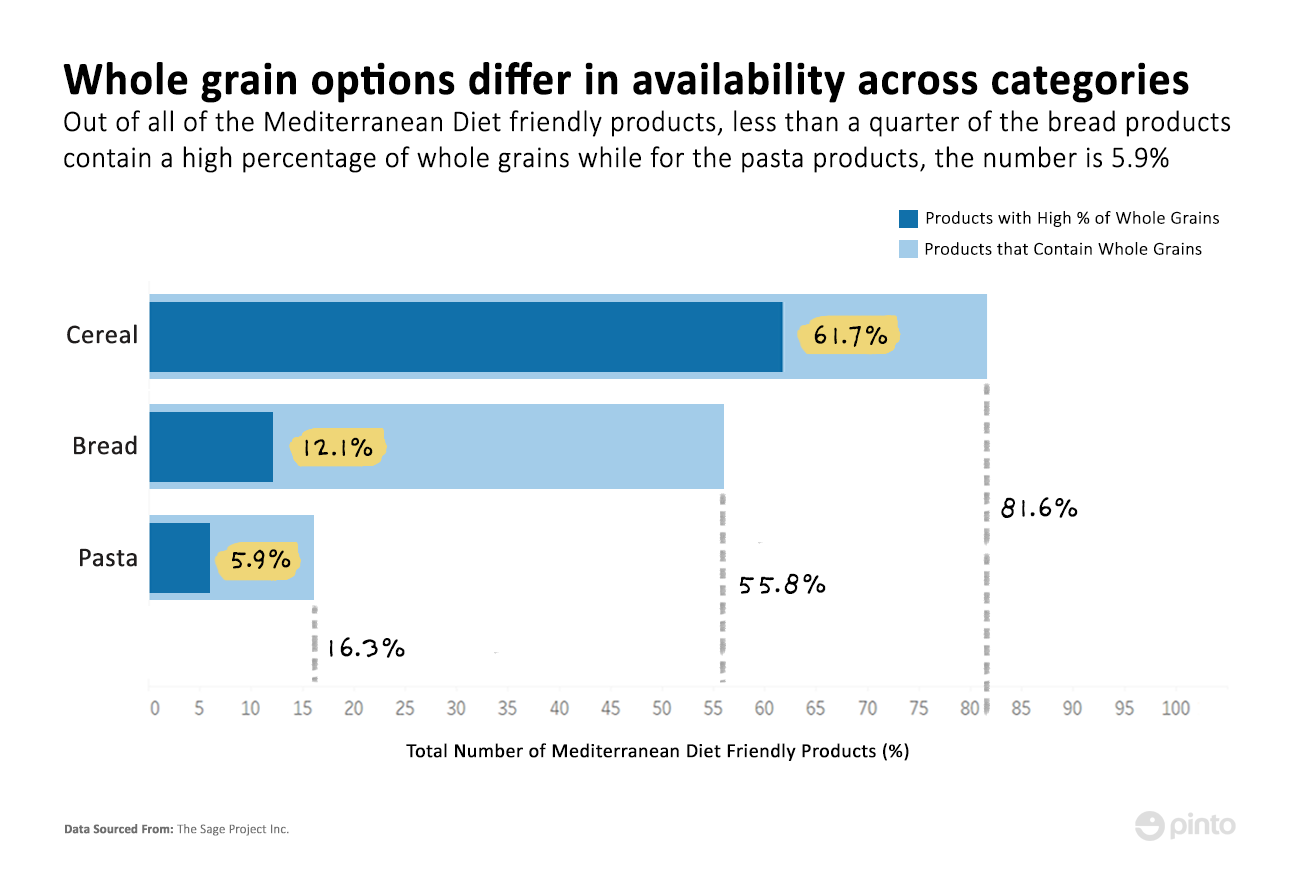
As shown above, for the bread and pasta categories, not many products have whole grains as the main ingredient—in fact, less than half do. The cereal category performs much better, with 61.7% of the products having whole grains as the main ingredient.
Companies do not have to disclose the ratio of refined-grains-to-whole-grains on the package. Sometimes, they include phrases such as “10g of whole grains per serving” but they do not tell you what the total grain content is. If it is 10g of whole grains out of 25g of total grains, then that’s still more refined grains than whole grains. Thus, many consumers remain fooled by this claim. The only way to be sure that the product is made out of solely whole grains is if the claim “100% whole grains” appears on the package. Manufacturers are only allowed to put this phrase on the package if the product is made with solely whole grains and contains no refined grains at all.
The market for the Mediterranean diet will only continue to grow
As interest around the Mediterranean diet continues to pick up steam, we recommend that grocers should consider including a "search and find" filter for the diet on their core product and e-commerce website. In doing so, they should also ensure that the products under the filter are not those that just “contain” whole grains but rather are products where the main ingredient is actually bonafide whole grains. Making it easy for consumers to find the appropriate products for the diet will eliminate the guesswork and allow them to follow the diet better.
Furthermore, we recommend that brands should consider taking leadership on ingredient transparency and disclose the full grain content of their products so that consumers have the full picture when it comes to whole grains vs refined grains. As consumers move toward demanding more transparency on nutrition labels, brands that take the first step will be poised to earn their loyalty.


